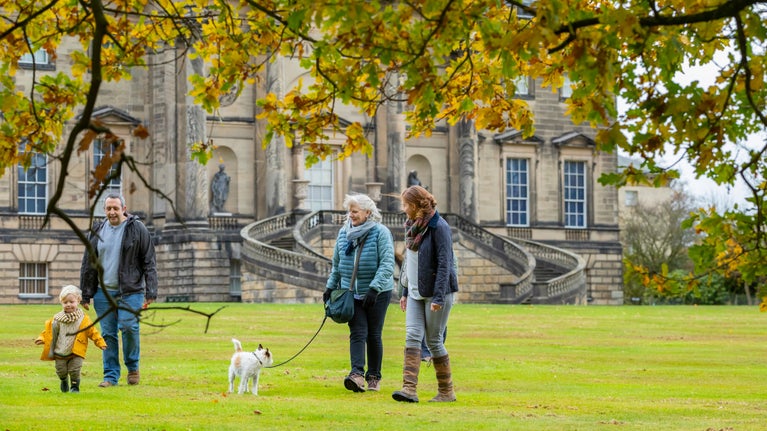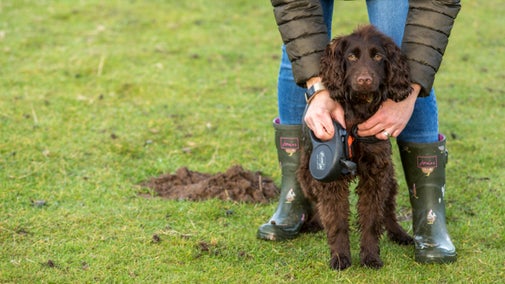
Discover more at Kedleston Hall
Find out when Kedleston Hall is open, how to get here, things to see and do and more.

Designed by Kedleston Hall’s architect Robert Adam, the parkland and pleasure grounds at Kedleston are a delight to explore. As you stroll through the estate, look out for seasonal wildlife in the parkland, marvel at the 18th-century flowerbeds and statues in the garden, and enjoy views of the hall. Discover the things to see in the grounds at Kedleston.
Robert Adam's south front of the Hall may well be the first thing you notice when you enter the garden at Kedleston. It was meant to impress when it was designed in the 18th century and it still does.
From the south front as you walk through the garden, you'll see a roaring lion and a funerary urn. Originally you wouldn't have seen the two together; trees and shrubs separated them and you'd almost stumble across the urn as you strolled past.
The lion statue, commissioned by Nathaniel Curzon in 1759, is a copy of a Renaissance sculpture made for the Villa Medici in Rome. Kedleston's lion statue is made of Portland stone and was created by Joseph Wilton. It stands on a plinth designed by Samuel Wyatt, who is believed to be responsible for the design of Kedleston's stables.
An ongoing project to reawaken the original features of the 18th-century garden at Kedleston began in 2019, resulting in a colourful display of flowers.
In previous years some of these flower beds were sown with a mix of wildflower seeds. This has since been replaced with a host of additional plants and flowers which will flower this spring. Look out for Berberis verruculasa (known as elephant ears), peonies as well as different foliage varieties. As these beds become more established it will help to provide colour and depth to the garden as they grow in the coming years.
Over the years it will change the view of the house depending on where you are in the garden (as intended in years gone by). If this has piqued your interest, why not take a summer evening tour of the garden at Kedleston Hall, with the Head Gardener and Apprentice Gardener? Learn about the plans for different areas of the gardens and the historical and horticultural features. 17 July 2024 - booking essential.
The Drayton Urn is a memorial funerary urn created by Robert Adam in memory of Michael Drayton, a poet who died in 1631. The urn was probably placed in the garden at the same time as the lion in 1766. The design for the urn was taken from a book on classical sculpture that is still in the Library at Kedleston.

The orangery at Kedleston was built in around 1800, alongside the Hexagon Temple or Summer House. It was designed by a former employee of Robert Adam’s architectural practice, and originally housed several orange and lemon trees.
Though it's now closed for safety reasons, it is still worth taking in the Grade II listed building as you walk around the pleasure grounds.
The hermitage is the only surviving 'incident' (stopping point) on the long walk. It was designed to be sombre and gloomy; a place for contemplation away from the glitz and glamour of the house.
Many great 18th-century houses had buildings like this in their grounds, taking their idea from the secluded huts of religious hermits of an earlier era. Some places even hired a hermit to act out the part of a recluse.
The hermitage was restored to its original state in 2017, complete with stone floor and thatched roof. You can now experience the hermitage just like an 18th-century visitor.
The park and pleasure grounds feature a variety of surfaces which can become muddy and slippery when wet. Step-free access into the gardens is accessed from the double gateway next to the Visitor Reception building by the main car park. This is partly surfaced but lead to lawned areas of grass, which can become soft when waterlogged.
The suggested walking routes are not fully accessible due to the presence of livestock gates, a narrow bridge, and stone steps and are not suitable for manual wheelchairs.

Find out when Kedleston Hall is open, how to get here, things to see and do and more.

The team at Kedleston have been doing important work to protect native species as well as conserve and create valuable wildflower habitats. Discover our work in the parkland and garden at Kedleston.

Pull on your walking boots and enjoy an adventure in Kedleston's beautiful surroundings, whether it’s a short stroll around Robert Adam’s pleasure ground, or a heartier walk for the more adventurous.

Visit the Hall at Kedleston, which is a prime example of 18th-century Palladian and Neoclassical inspired architecture and the ancestral residence of the Curzon family.

Kedleston is a two pawprint rated place. Well-behaved dogs on leads are welcome throughout the gardens and parkland, with great walks for you both to enjoy.

Open daily, the Great Kitchen restaurant serves up hot and cold lunches and snacks, an ideal pitstop before or after your walk or buy a souvenir of your visit in the gift shop.

Plan a visit to one of the special countryside places in our care and discover the benefits of being in the great outdoors. Pack your walking boots and get ready to explore woodlands, valleys and rivers.

Find out about the extensive countryside and woodland places to explore in the Peak District and Derbyshire, from rugged peaks to wide expanses of moorland.

Explore some of the finest landscapes in our care on coastal paths, accessible trails, woodland walks and everything in between. Find the best places to walk near you.